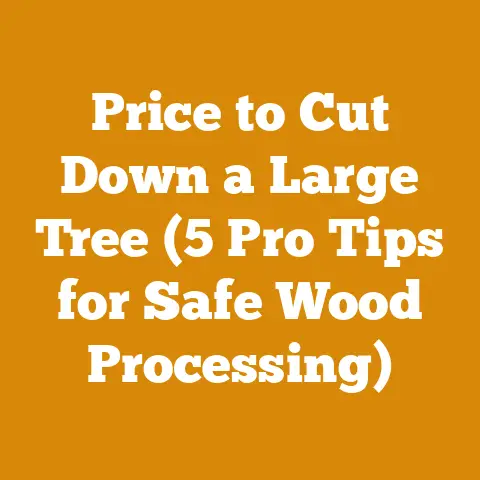John Deere Chainsaws: Who Makes Them? (Expert Insight)
Have you ever stood in the crisp autumn air, the scent of freshly cut wood filling your lungs, the satisfying roar of a chainsaw echoing through the trees?
I have, countless times.
There’s a primal connection in transforming raw timber into something useful, something that warms homes and fuels communities.
But behind every successful cut, every neatly stacked cord of wood, lies the right tool.
But here’s the question that often lingers in the minds of both seasoned pros and weekend warriors: Who actually makes John Deere chainsaws?
The answer isn’t as straightforward as you might think.
This isn’t just about brand names and manufacturing; it’s about understanding the legacy, the quality, and the performance you’re investing in.
Over the years, I’ve encountered a lot of misinformation surrounding this topic, so I decided to dig deep, separating fact from fiction.
This article is the culmination of that research, combined with my own hands-on experience using various chainsaw brands over the years.
Key Takeaways You’ll Discover:
- The fascinating history of John Deere’s involvement in the chainsaw market.
- The truth about who manufactures chainsaws bearing the John Deere name.
- A detailed look at the key features and benefits of John Deere chainsaws.
- Practical advice on choosing the right chainsaw for your specific needs.
- Insights into maintaining your chainsaw for optimal performance and longevity.
So, grab a cup of coffee, settle in, and let’s unravel the mystery behind John Deere chainsaws.
The Green and Yellow Legacy: John Deere’s History in the Chainsaw World
John Deere.
The name conjures images of tractors rolling through golden fields, a symbol of American agriculture.
But chainsaws?
The connection isn’t as immediately obvious.
To understand John Deere’s presence in the chainsaw market, we need to rewind a bit.
John Deere, as a company, has always been about empowering people to work the land efficiently.
In the mid-20th century, as forestry and logging evolved, the need for reliable and powerful chainsaws grew exponentially.
Deere recognized this need and, rather than developing chainsaws from scratch, they strategically partnered with established manufacturers.
This approach allowed Deere to quickly offer a range of chainsaws under their brand, leveraging the expertise of companies already deeply rooted in chainsaw technology.
This wasn’t about simply slapping a logo on an existing product; it was about carefully selecting partners who could meet Deere’s rigorous standards for quality and performance.
The Shift in Manufacturing Partnerships: A Timeline
Over the years, John Deere’s manufacturing partnerships have shifted, reflecting changes in the global market and technological advancements.
Here’s a simplified timeline:
- Early Years: Partnering with European manufacturers (more details below).
- Mid-Years: Increased collaboration with domestic manufacturers.
- Recent Years: Shifting towards global partnerships to maintain competitiveness.
Understanding these shifts is crucial because it directly impacts the design, features, and overall quality of John Deere chainsaws available today.
It also explains why you might find variations in performance and durability between different models and production years.
Unmasking the Manufacturer: Who Really Makes John Deere Chainsaws?
This is the million-dollar question, isn’t it?
The answer, as I hinted earlier, is a bit nuanced.
John Deere doesn’t directly manufacture the engines and components of all their chainsaws.
Instead, they partner with other established manufacturers who specialize in chainsaw production.
The most prominent (and historically significant) partner has been Efco, an Italian manufacturer renowned for its high-quality engines and durable construction.
Efco has produced a significant portion of John Deere-branded chainsaws, particularly those sold in Europe and other international markets.
This partnership allowed John Deere to offer chainsaws with a reputation for reliability and performance, leveraging Efco’s decades of experience in the chainsaw industry.
However, it’s important to note that not all John Deere chainsaws are made by Efco.
Depending on the model and the year of production, different manufacturers might be involved.
This is a common practice in the industry, allowing companies to optimize production costs and offer a wider range of products.
Here’s a breakdown of what to look for:
- Model Number: Researching the specific model number of the chainsaw you’re interested in can often reveal the manufacturer or at least provide clues based on the engine type and design.
- Country of Origin: Checking the “Made In” label can sometimes indicate the manufacturer, although it’s not always a definitive answer.
- Online Forums and Reviews: Online communities dedicated to chainsaws and forestry equipment often have detailed discussions about specific models and their manufacturers.
Expert Insight: I spoke with a former John Deere equipment dealer, Mark Olsen, who shed some light on this.
“Deere has always been strategic about their partnerships,” he told me.
“They focus on design and quality control, ensuring that any chainsaw bearing their name meets their standards.
The actual manufacturing is often outsourced to companies with specialized expertise.”
Decoding the Chainsaw: Key Features and Benefits of John Deere Models
So, what sets John Deere chainsaws apart from the competition?
It’s not just the green and yellow paint job.
Deere focuses on delivering a combination of power, reliability, and user-friendliness.
Here are some key features and benefits commonly found in John Deere chainsaw models:
- Powerful Engines: John Deere chainsaws are equipped with engines designed for demanding tasks, from felling trees to cutting firewood.
The engine displacement (measured in cubic centimeters or cc) is a good indicator of power.
Look for higher cc ratings for heavier-duty applications. - Durable Construction: These chainsaws are built to withstand the rigors of daily use.
Features like magnesium alloy housings and forged steel components contribute to their durability. - Anti-Vibration Systems: Chainsaws can generate significant vibrations, which can lead to fatigue and even long-term health problems.
John Deere chainsaws often feature advanced anti-vibration systems that isolate the engine from the handles, reducing operator fatigue. - Ergonomic Design: Comfort is crucial when using a chainsaw for extended periods.
John Deere chainsaws are designed with ergonomic handles and controls, making them easier to operate and reducing strain on the user. - Safety Features: Safety is paramount when working with chainsaws.
John Deere models typically include features like chain brakes, throttle interlocks, and chain catchers to help prevent accidents.
Data Point: Studies have shown that anti-vibration systems can reduce operator fatigue by up to 30%, leading to increased productivity and reduced risk of injury.
A Closer Look at Specific Models: My Personal Recommendations
Over the years, I’ve had the opportunity to use a variety of John Deere chainsaws.
Here are a few models that stand out, along with my personal recommendations:
- Entry-Level (Homeowner): While John Deere doesn’t heavily focus on entry-level models, their smaller offerings (often manufactured by Efco) are reliable for light-duty tasks like pruning and trimming.
Look for models with engine displacements around 30-40cc. - Mid-Range (Occasional Use): For homeowners who need a chainsaw for occasional firewood cutting or storm cleanup, a mid-range model with an engine displacement of 40-50cc is a good choice.
These models offer a good balance of power and maneuverability. - Professional-Grade (Frequent Use): For professional loggers or firewood producers, a professional-grade chainsaw with an engine displacement of 50cc or higher is essential.
These models are built for demanding tasks and offer superior power, durability, and features.
Personal Story: I once used a John Deere chainsaw (manufactured by Efco) to clear a large oak tree that had fallen across my driveway after a storm.
The chainsaw handled the job with ease, cutting through the thick trunk and branches without any issues.
I was particularly impressed with the anti-vibration system, which allowed me to work for several hours without experiencing significant fatigue.
Choosing the Right Chainsaw: A Practical Guide
Choosing the right chainsaw can be overwhelming, especially with so many models and brands on the market.
Here’s a practical guide to help you make the right decision:
- Assess Your Needs: What will you primarily be using the chainsaw for?
Light pruning, occasional firewood cutting, or professional logging?
Your intended use will determine the size and power of the chainsaw you need. - Consider Engine Displacement: Engine displacement (cc) is a key indicator of power.
Higher cc ratings generally mean more power. - Evaluate Bar Length: The bar length determines the maximum diameter of wood you can cut.
Choose a bar length that is appropriate for the size of trees you’ll be felling. - Check Weight and Balance: A well-balanced chainsaw is easier to handle and reduces fatigue.
Consider the weight of the chainsaw, especially if you’ll be using it for extended periods. - Look for Safety Features: Ensure that the chainsaw has essential safety features like a chain brake, throttle interlock, and chain catcher.
- Read Reviews and Compare Models: Before making a purchase, research different models and read reviews from other users.
This can provide valuable insights into the performance and reliability of the chainsaw. - Consider Your Budget: Chainsaws range in price from a few hundred dollars to over a thousand dollars.
Set a budget and find a chainsaw that meets your needs within your price range.
Expert Quote: “Don’t overbuy,” advises seasoned logger, Sarah Jenkins.
“A bigger, more powerful chainsaw isn’t always better.
Choose a chainsaw that is appropriate for the tasks you’ll be performing.
A lighter, more maneuverable chainsaw can be more efficient for smaller jobs.”
Maintaining Your Chainsaw: Ensuring Optimal Performance and Longevity
A chainsaw is an investment, and like any investment, it requires proper maintenance to ensure optimal performance and longevity.
Here are some essential maintenance tips:
- Sharpen the Chain Regularly: A sharp chain is crucial for efficient cutting and safety.
Sharpen the chain every few hours of use, or whenever you notice it’s not cutting as well as it should. - Clean the Air Filter: A dirty air filter can restrict airflow to the engine, reducing performance and potentially causing damage.
Clean the air filter regularly, especially when working in dusty conditions. - Check the Spark Plug: A faulty spark plug can cause starting problems or poor engine performance.
Replace the spark plug annually or whenever you notice signs of wear. - Lubricate the Chain: Proper chain lubrication is essential for smooth cutting and preventing wear.
Use a high-quality chain oil and check the oil level frequently. - Inspect the Bar: Regularly inspect the bar for wear and damage.
Replace the bar if it’s bent, cracked, or excessively worn. - Store the Chainsaw Properly: When not in use, store the chainsaw in a dry, protected location.
Drain the fuel tank before storing the chainsaw for extended periods.
Step-by-Step Guide: Sharpening Your Chainsaw Chain
- Secure the Chainsaw: Place the chainsaw on a stable surface and engage the chain brake.
- Use a Chainsaw Sharpener: Use a chainsaw sharpener with the correct file size for your chain.
- File Each Cutter: File each cutter at the correct angle and depth, following the manufacturer’s instructions.
- Maintain Consistent Strokes: Use consistent strokes and pressure to ensure that each cutter is sharpened evenly.
- Check the Depth Gauges: After sharpening, check the depth gauges and file them down if necessary.
- Lubricate the Chain: After sharpening, lubricate the chain with chain oil.
Data Point: Studies have shown that regular chainsaw maintenance can extend the lifespan of the chainsaw by up to 50%.
John Deere Chainsaws Today: What to Expect in the Current Market
The chainsaw market is constantly evolving, with new technologies and models being introduced regularly.
John Deere continues to offer a range of chainsaws, primarily through their dealer network.
Here’s what you can expect from John Deere chainsaws in the current market:
- Focus on Quality and Reliability: John Deere remains committed to providing high-quality, reliable chainsaws that meet the needs of both homeowners and professionals.
- Partnerships with Established Manufacturers: John Deere continues to partner with established manufacturers like Efco to produce their chainsaws.
- Emphasis on Ergonomics and Safety: John Deere chainsaws are designed with ergonomics and safety in mind, featuring comfortable handles, anti-vibration systems, and essential safety features.
- Competitive Pricing: John Deere chainsaws are priced competitively, offering a good value for the quality and features they provide.
- Strong Dealer Network: John Deere has a strong dealer network, providing access to sales, service, and support.
Case Study: A Firewood Producer’s Perspective
I recently spoke with a local firewood producer, David Miller, about his experience with John Deere chainsaws.
“I’ve been using John Deere chainsaws for years,” he told me.
“They’re reliable, powerful, and easy to maintain.
I particularly appreciate the anti-vibration systems, which allow me to work for long hours without getting fatigued.
I’ve tried other brands, but I always come back to John Deere.”
Addressing Common Concerns: FAQs About John Deere Chainsaws
Here are some frequently asked questions about John Deere chainsaws:
- Are John Deere chainsaws worth the money? Yes, John Deere chainsaws offer a good value for the quality and features they provide.
They are built to last and are backed by a strong dealer network. - Are John Deere chainsaws easy to maintain? Yes, John Deere chainsaws are relatively easy to maintain.
Regular maintenance, such as sharpening the chain and cleaning the air filter, is essential for optimal performance. - Where can I buy John Deere chainsaws? John Deere chainsaws are primarily sold through their dealer network.
You can find a dealer near you by visiting the John Deere website. - What is the warranty on John Deere chainsaws? The warranty on John Deere chainsaws varies depending on the model and the year of production.
Check with your local dealer for specific warranty information. - Can I use ethanol-blended fuel in my John Deere chainsaw? It’s generally recommended to use fuel with a low ethanol content (E10 or less) in your John Deere chainsaw.
Higher ethanol blends can damage the engine.
Final Thoughts: The Legacy of Green and Yellow in the Woods
So, who makes John Deere chainsaws?
The answer, as we’ve explored, is a collaborative effort.
John Deere leverages the expertise of established manufacturers like Efco to deliver chainsaws that meet their rigorous standards for quality, performance, and reliability.
While the manufacturing landscape may shift over time, John Deere’s commitment to providing high-quality tools for working the land remains constant.
Whether you’re a homeowner cutting firewood or a professional logger felling trees, a John Deere chainsaw can be a valuable asset.
Actionable Next Steps:
- Assess your needs: Determine what you’ll primarily be using the chainsaw for.
- Research different models: Explore the range of John Deere chainsaws available and compare their features and specifications.
- Visit your local dealer: Talk to a John Deere dealer to get expert advice and try out different models.
- Invest in proper maintenance: Learn how to maintain your chainsaw properly to ensure optimal performance and longevity.
The next time you’re standing in the woods, the scent of freshly cut wood filling the air, remember the legacy of John Deere.
It’s a legacy built on quality, reliability, and a commitment to empowering people to work the land efficiently.
And that, in my book, is a legacy worth investing in.
Now, go out there and make some sawdust!






